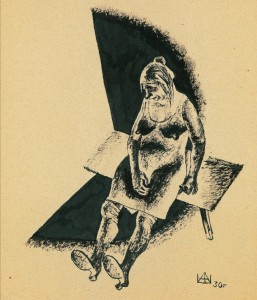In reality, the artists’ societies of the 1920s became at once both unions for like-minded artists and arenas for acute conflicts over world views, theories and human relations. Within these societies there were parties and within the parties there were alignments hostile to one another. Debates held by these internal parties were sometimes more intense and painful than arguments with external opponents.
Was the expressionist wing of the Painter’s Guild related to the work of Alexander Golovanov? Viting calls him the “soul” and “inspirer” of the society. [12] All we can do is take note of this author’s testimony.
The Painter’s Guild brought together, or rather caused to collide, such disparate artists as: the reflective Valeriy Kapterev, whose works, if regarded as texts, closely resemble parables; Nikolai Viting, who was in those early years producing his first works of art and paying careful attention to contemporary art in the West; Rostislav Barto, the favorite disciple of Alexander Shevchenko and a true prodigy, who made masterful use of both the contemporary and historic languages of painting; and Boris Golopolosov, in whose paintings the internal relationships do not simply appear but burst out, and whose art idiom is like a dull scalpel that rips apart a living, feeling body, exposing the raw, pulsating muscles underneath the surface. Golopolosov is probably the artist to whom Viting’s label “Soviet expressionist” can be applied in full. Since the subjects of his works are easily taken as symbols, allegories, and metaphors, Golopolosov’s art is manifestly related to early European expressionism, or protoexpressionism, which grew out of the culture of symbolism and drank the last drops of its blood.
But Golopolosov also went down the tragic path of a 20th century artist, so the meaning of his artistic legacy is not fully exhausted by establishing this historical relationship.
The artist regards the idiom of art as something that feels rejection, pain and fear. Hearing the din made by this language, he goes from incident to incident, and accepts the changes occurring in reality as events that alter it. That which makes the artist himself has very little to do with this reality; thus, he is overwhelmed by the feeling of being utterly alone.



